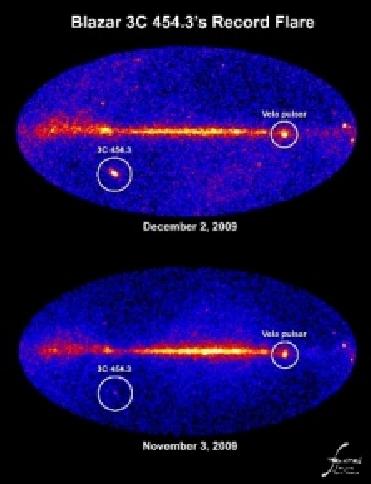
Unprecedented flares from blazar 3C 454.3 in the constellation Pegasus make it the brightest gamma-ray source in the sky. That title usually goes to the Vela pulsar in our galaxy, which is millions of times closer. These all-sky images, which show the numbers of high-energy gamma-rays captured by Fermi's Large Area Telescope on December 3 and November 18, clearly show the change. Image credit: NASA
WASHINGTON (BNS): An active galaxy, located 7.2 billion light years away in the constellation of Pegasus, has become the brightest source of gamma ray flares.
NASA�s Fermi Gamma-ray Space Telescope has spotted the object, identified as 3C 454.3, where the flares started in September 15, making it brighter than it was in summer.
It has also replaced the Vela pulsar located in our galaxy as the richest gamma-ray source.
�We're looking right down the barrel of a particle jet powered by the galaxy's supermassive black hole. Some change within that jet � we don't know what � is likely responsible for these flares,� said Gino Tosti at the National Institute of Nuclear Physics in Perugia, Italy.
3C 454.3 is a type of object known as �blazar�. Blazars, like many active galaxies, emit oppositely directed jets of particles traveling near the speed of light when matter falls toward their central supermassive black holes.
What makes a blazar so bright in gamma rays is its orientation: One of the jets happens to be aimed straight at Earth, NASA said.
Most of the time, the brightest persistent source in the gamma-ray sky is the Vela pulsar, which at a distance of about 1,000 light-years lies practically next door.
�3C 454.3 is millions of times farther away, yet the current flare makes it twice as bright as Vela,� explained Lise Escande at the Center for Nuclear Studies in Gradignan, near Bordeaux, France.
�That represents an incredible energy release, and one the source can't sustain for very long,� Escande said.
The galaxy is also flaring at radio and visible wavelengths, though less dramatically. So, the Fermi team is alerting astronomers to monitor the event over as broad a range of wavelengths as possible.
�That's our best bet for understanding what's going on inside that jet,� Tosti said.
 Previous Article
Previous Article Next Article
Next Article












The Indian Air Force, in its flight trials evaluation report submitted before the Defence Ministry l..
view articleAn insight into the Medium Multi-Role Combat Aircraft competition...
view articleSky enthusiasts can now spot the International Space Station (ISS) commanded by Indian-American astr..
view article